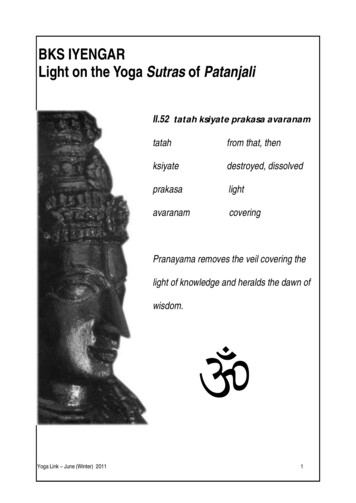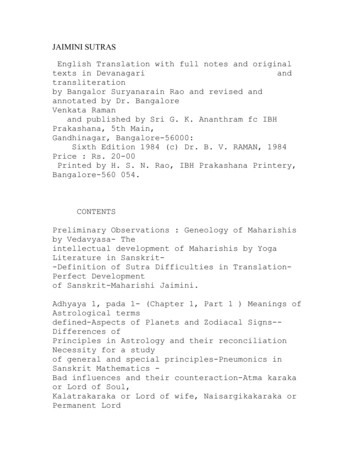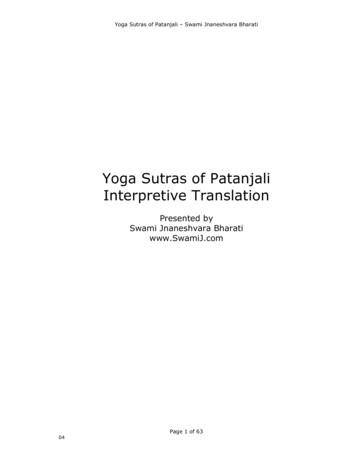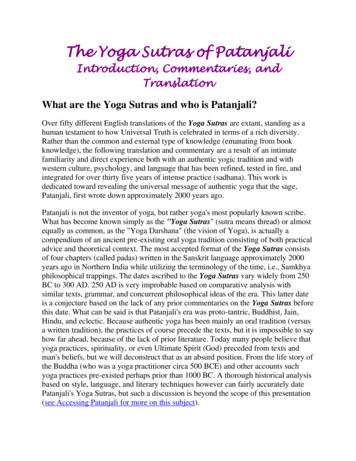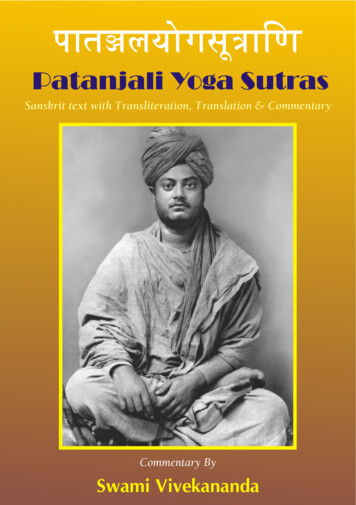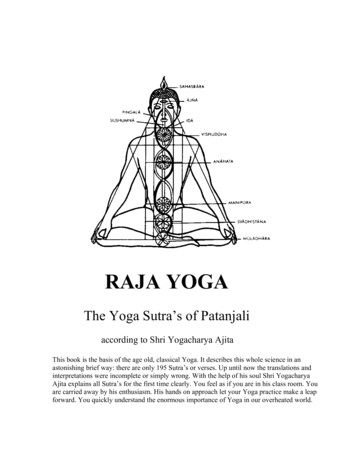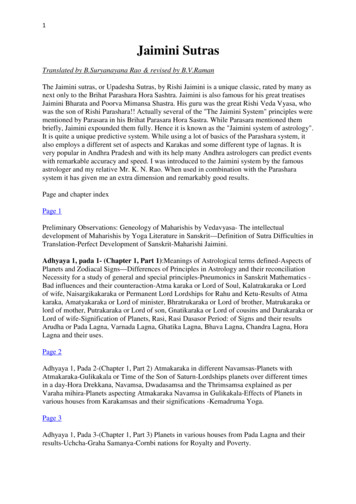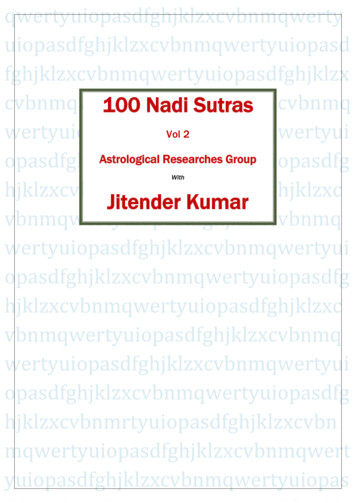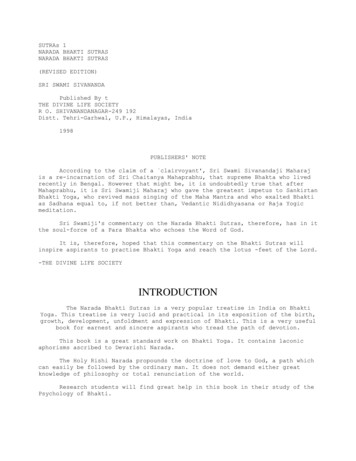
Transcription
SUTRAs 1NARADA BHAKTI SUTRASNARADA BHAKTI SUTRAS(REVISED EDITION)SRI SWAMI SIVANANDAPublished By tTHE DIVINE LIFE SOCIETYR O. SHIVANANDANAGAR-249 192Distt. Tehri-Garhwal, U.P., Himalayas, India1998PUBLISHERS' NOTEAccording to the claim of a clairvoyant', Sri Swami Sivanandaji Maharajis a re-incarnation of Sri Chaitanya Mahaprabhu, that supreme Bhakta who livedrecently in Bengal. However that might be, it is undoubtedly true that afterMahaprabhu, it is Sri Swamiji Maharaj who gave the greatest impetus to SankirtanBhakti Yoga, who revived mass singing of the Maha Mantra and who exalted Bhaktias Sadhana equal to, if not better than, Vedantic Nididhyasana or Raja Yogicmeditation.Sri Swamiji's commentary on the Narada Bhakti Sutras, therefore, has in itthe soul-force of a Para Bhakta who echoes the Word of God.It is, therefore, hoped that this commentary on the Bhakti Sutras willinspire aspirants to practise Bhakti Yoga and reach the lotus -feet of the Lord.-THE DIVINE LIFE SOCIETYINTRODUCTIONThe Narada Bhakti Sutras is a very popular treatise in India on BhaktiYoga. This treatise is very lucid and practical in its exposition of the birth,growth, development, unfoldment and expression of Bhakti. This is a very usefulbook for earnest and sincere aspirants who tread the path of devotion.This book is a great standard work on Bhakti Yoga. It contains laconicaphorisms ascribed to Devarishi Narada.The Holy Rishi Narada propounds the doctrine of love to God, a path whichcan easily be followed by the ordinary man. It does not demand either greatknowledge of philosophy or total renunciation of the world.Research students will find great help in this book in their study of thePsychology of Bhakti.
The Sutras have an expressible charm and beauty. They make a direct appealto the heart. Narada speaks to all alike. There is not even the slightest traceor tinge of sectarianism.And they are the best authority on the Bhakti Marga. For sincere devoteeswho are in need of practical spiritual instructions, in a very short compass, inthe path of devotion or divine love, there is no better book than Narada BhaktiSutras. The language is very simple.The Bhakti Sutras of Narada number 84 in all. The first twenty-four ofthem deal with the nature of Bhakti. The next nine Sutras, i.e., 25 to 33explain why and how the path of Bhakti is superior to Karma, Jnana and Yoga.Sutras 34 to 50 (seventeen in all) describe the methods by which Bhaktimay be practised and developed.The next sixteen Sutras (51 to 66) give a description of the externalmarks by which Bhakti can be detected in a true devotee.The last 18 Sutras (67 to 84) glorify the great realised souls who arefull of devotion to the Lord.ORIGIN OF NARADA BHAKTI SUTRASSri Veda Vyasa was staying in his hermitage of Badarikasrama. One dayNarada went to the Ashram in the course of his wanderings. Sri Vyasa welcomedthe Rishi with due rites and said, "Man seeks freedom, etc. But without devotionit is dry. Devotion is the only way for attaining salvation. All the others haveimportance only in so far as they are auxiliary to it. I humbly ask you toexplain to me the virtue of devotion."Narada said, "Your disciple Jaimini has already discussed the problem ofaction in the Purva Mimamsa. You have yourself completed the enquiry of theproblem of knowledge in the Uttara Mimamsa. Now you have taken up the problem ofdevotion. Its full explanation will be given by you in your Srimad Bhagavatam. Ishall explain Bhakti in the form of Sutras." So saying Narada delivered adiscourse on devotion in 84 aphorisms.The collection of these Sutras forms a short treatise, known asNarada-Bhakti Sutras (Vide Srimad Bhagavatam (1-4 and 5).DEVOTIONThe path of Bhakti consists of a gradation of steps. The desire forrelease from the evil of mortality and the sufferings is its starting point.Para Bhakti or Higher devotion is its goal. It is Para Bhakti that leads toMukti.Subsidiary to Para Bhakti, Ekanta-bhava, whole hearted devotion, there arevarious forms of devotional states, 81 in number.Illiterates, females, outcastes-are all equally competent to follow thepath of devotion. Desire for release or Mumukshutva is the minimumqualification.
An objector says, God is far above the power of comprehension of man. How,then can one cultivate devotion to Him?Live in the company of saints. Hear the lilas of God. Study the sacredscriptures. Worship Him first in His several forms as manifested in the world.Worship any image or picture of the Lord or Guru. Recite His name. Sing Hisglories. You will develop devotion.According to some, Jnana is instrumental in the cultivation of Bhakti,while others say that they are mutually dependent. But Narada says that Bhaktiis the fruit or result of itself.Devotion is the highest sentiment. Narada has dealt with the subject fromthe point of view of sentiment alone. Whereas the Bhakti-Mimamsa of Sandilya isan enquiry into the philosophy of devotion. The two treatises are companions.They supplement each other.When the devotee grows in devotion there is absolute self-forgetfulness.This is called Bhava. Bhava then grows into Maha-Bhava wherein the devoteelives, moves and has his being in the Lord. This is Parama-Prema, theconsummation of love or supreme love.The nine modes of Bhakti have each nine varieties. Therefore Saguna Bhaktibecomes eighty-one fold.By fixing the mind on the Lord through love, hate, fear, friendship, manyhave attained God-realisation, e.g., the Gopis through love, Kamsa through fear,Sisupala through hate, the Vrishnis through relationship.Devotion is indicated by Sanmana (honour) as in the case of Arjuna,Bahumana (exaltation) as in the case of Ikshvaku, Prithi (love) as in the caseof Vidura, Viraha (pangs of separation) as in the case of Gopis,Itara-vichikitsa (disinclination to others) as in the case of Upamanyu,Mahima-Khyati (glorification) as in the case of Yama, Tadartha-pran-sthana(living for Him) as in the case of Hanuman, Tadiyata (the belief that everythingbelongs to Him) as in the case of Uparichara Vasu, Sarva-tad-bhava (theconsciousness that the Lord is immanent in all things) as in the case ofPrahlada, a-pratikula (non-opposition) as in the case of Bhishma.Bhakti Yoga is the one Yoga which directly appeals to the feelings of man.Apara Bhakti is lower Bhakti. It is a premature stage in devotion. Mature stageof subjective experience is known as Para Bhakti. The devotee has ineffableinner experience of unsurprising bliss and illumination. He has God-realisation.There are two stages in Apara or lower Bhakti. The first stage is calledGauna or secondary; the second stage is Mukhya or primary. In Gauna Bhakti thereis the influence of Rajo Guna; in Mukhya Bhakti there is influence of SattvaGuna. The mind is calm and serene. Meditation becomes firm and steady. Thedevotee is in the presence of God. He is conscious of duality.In Para Bhakti the devotee attains the full grace of the Lord, knowledgeand full illumination. He merges in the Lord; he loses his identity. He becomesone with the Lord.Your happiness depends upon the nature of the object on which you set yourheart. The only true object of love is the Lord who is omnipotent, omnipresentand omniscient and all-merciful.
Love of God or devotion is more a practice than a philosophy. Devotiondethrones the ego and enthrones the Lord in its place. The climax of love is thelove of God. Service of the saints, association with the saints, study of Bhaktiliterature, charity, self-restraint, humility, Japa, Kirtan, prayer-this is thepreparation for the love of God.NAMAPARADHAS(Offence against Divine Name)The Glory of the Names of the Lord is indescribable. A devotee should tryto avoid the sixty-four offences against Divine Name (Namaparadhas)They are: 1. To recognise God as a deity or a principle, 2. To look uponthe Vedas as a book or as having an author, 3. To discriminate between Bhaktason ground of their caste, 4. To look upon one's preceptor as an ordinary humanbeing, 5. To regard an image or picture of God as wood, stone, metal, paper orclay, 6. To treat Prasada (food offered to the Lord) as ordinary food, 7. Totreat Charanamrita (water in which the sacred feet of an image of God have beenwashed) as ordinary water, 8. To regard Tulsi (the basil plant) as an ordinaryplant, 9. To regard the cow as an ordinary beast, 10. To regard the Gita or theBhagavata as an ordinary book, 11. To regard the Divine sports as humanactivities , 12. To compare the sports of the Lord with earthly love orsex-pleasure, 13. To regard the Gopis as others' wives (in relation to theLord), 14. To regard the Rasa dance of Sri Krishna as an amorous sport, 15. Todiscriminate (between touchables and untouchables) in festivities connected withthe Lord, 16. To have no faith in God and the Shastras and to turn anunbeliever, 17. To practise Dharma with a doubting mind, 18. To be slothful indischarging one's religious duties, 19. To judge devotees by external things,20. To comment on the merits and demerits of saints, 21. To have a high opinionabout one's own self, 22. To revile a particular God or scripture, 23. To turnone's back on an image of God, 24. To approach an image of God with shoes on,25. To wear a garland in the presence of an image of God, 26. To approach animage of God, stick in hand, 27 . To approach an image of God, in a bluegarment, 28. To approach an image of God, without washing one's mouth andcleaning one's teeth, 29. To enter a temple of God without changing one'sclothes, after evacuating one's bowels or sexual intercourse, 30. To stretchone's arms or legs before an image of God, 31. To chew betel-leaves before animage of God, 32. To laugh loudly before an image of God, 33. To makeundesirable gesture, 34. To hover around women, 35. To lose one's temper, 36. Tosalute anyone else in the presence of an image of God, 37. To visit a templeimmediately after eating something which gives a foul odour, 38. To insult orassault anyone, 39. To make gestures expressive of lust or anger, 40. To fail inone's duty to a stranger or a holy man, 41. To regard oneself as a devotee, apious soul, a learned man or a virtuous man, 42. To associate with unbelievers,profligates, sanguinary persons, greedy men and liars, 43. To blame God inadversity, 44. To practise virtue with a sinful motive, 45. To regard oneself aspious even though oppressing anyone even slightly, 46. To refuse to maintainone's wife, children, family, dependents, the needy and holy men, 47. To offersomething to God treating it as enjoyable by oneself or to enjoy it withoutoffering it to God beforehand, 48. To swear by the name of one's Ishta Devata,49. To sell Dharma and the Name of God, 50. To expect anything from anyone elsethan one' s chosen deity, 51. To violate the injunctions of the Sastras, 52. Tobehave as a knower of Brahman, even though lacking such knowledge, 53. Todiscriminate between Vaishnavas belonging to different sects, 54. To behave as aGod, 55. To revile particular Avataras by discriminating between their
respective Lilas, 56. To call anyone as God, even by mistake, 57. To believeGod, even by mistake, to be dependent on anyone else, 58. To give the Prasada orCharanamrita of the Lord to anyone through greed, 59. To insult a picture, imageor Name of God, 60. To oppress, intimidate or wrong anyone, 61. To renouncefaith on losing in a controversy or on one's failure to establish a proposition,62. To regard the birth and activities of the various Avataras as commonplace,63. To regard the pair forms of the Deity, such as Sri Radha and Sri Krishna, asdistinct or separate, and 64. As an overzealous disciple to act against thespirit of Guru's behest.LIFE OF NARADAIDeva Rishi Narada moves about playing on his Veena, singing the praises ofSri Hari drawing the hearts of people towards God thus radiating joy, love andpeace throughout the afflicted world. Glory to Devarishi Narada!Through the power of Yoga he can go wherever he likes in the twinkling ofan eye. The misunderstanding and quarrels he creates are all intended for thegood of the world. He inspired Valmiki, Vyasa, Sukadeva, Prahlada, Dhruva andother great souls to practise devotion.Narada was the son of a female servant in his former birth. A large numberof saints, sages and Sannyasins came to his village during a certain rainyseason to spend their four months of Chaturmas. Narada was a small child at thattime. His mother engaged him in their service. He was not childish. He gave upall childish plays. He spoke a very few words. He served them beautifully andwholeheartedly. He served all his time quietly at their feet. The Mahatmas werevery much pleased with the boy. They were extremely kind to him. As ordered bythem he ate what was left of the food left by them on the leaves. His sins weredestroyed by this act. His heart became pure. He heard the beautiful stories ofSri Krishna recited by them. He gradually developed Bhakti. His mind became firmand steady. The Mahatmas gave him special instructions and revealed the secretof divine knowledge.The Mahatmas left the village. The boy continued to practise Sadhana. Hedid Bhajan.One day a snake bit his mother and she died. The boy left the village andwent to a dense forest. He sat underneath a Peepul tree on the bank of a riverand meditated on Lord Hari.The Lord revealed Himself in his heart. The hairs of his body stood erect.He forgot all about the world and even the consciousness of his own existence.He was immersed in the ocean of bliss.Then suddenly the Form of Lord Hari disappeared. The boy was very muchgrieved. He again tried to have the vision of the Lord. He heard a voice fromthe sky. "O Child! You cannot again get My vision in the present birth. Irevealed Myself to you now in order to increase and strengthen your love towardsMe. You have cultivated strong devotion to Me through the influence of Satsangaeven for a short time. When you leave your present body, you will be a devoteevery near and dear
Sutras. The language is very simple. The Bhakti Sutras of Narada number 84 in all. The first twenty-four of them deal with the nature of Bhakti. The next nine Sutras, i.e., 25 to 33 explain why and how the path of Bhakti is superior to Karma, Jnana and Yoga. Sutras 34 to
